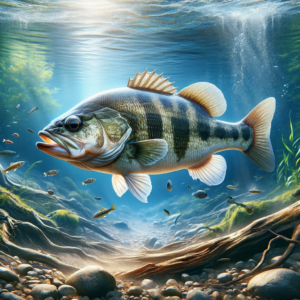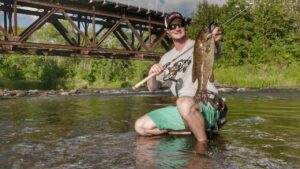Are you concerned about the declining population of smallmouth bass? Smallmouth bass, a popular sport fish, have been facing a significant decline in their numbers in recent years. This decline has raised concerns among anglers, scientists, and conservationists alike. In this article, we will discuss the factors contributing to the decline of smallmouth bass populations and the potential implications for their future survival.
Smallmouth bass are known for their aggressive nature and their ability to put up a great fight when caught on a line. However, their populations have been steadily declining in many bodies of water across the United States. There are several factors that could be contributing to this decline, including habitat loss, pollution, and changes in water temperature and quality. These factors can disrupt the natural balance of the ecosystem and negatively impact the survival and reproduction of smallmouth bass.
Understanding the reasons behind the decline of smallmouth bass populations is crucial for developing effective conservation strategies. By studying the factors influencing their decline, scientists can work towards restoring their habitats and implementing measures to protect their populations. In the following sections, we will dive deeper into these issues and explore the potential solutions that can help reverse the decline of smallmouth bass populations. So, stay tuned to learn more about this important topic and how we can work together to ensure the future survival of smallmouth bass.
Introduction
Smallmouth bass (Micropterus dolomieu) are a popular freshwater fish species among anglers and play a significant role in the ecosystem. However, in recent years, their population has been declining at an alarming rate. This article will explore the importance of smallmouth bass, the factors contributing to their decline, the impact of their declining population, conservation efforts, success stories, challenges and limitations, and the future outlook for these fascinating creatures.
The Importance of Smallmouth Bass
Their role in the ecosystem
Smallmouth bass are predatory fish that play a vital role in maintaining the balance of the ecosystem. They help control the population of smaller fish species and help regulate their populations. Additionally, they serve as an important link in the food chain, as they are preyed upon by larger fish and birds. The presence of smallmouth bass in freshwater systems is necessary for maintaining the overall health and stability of the ecosystem.
Economic value to local communities
Smallmouth bass also hold great economic value to local communities, particularly those heavily reliant on recreational fishing. Their popularity among anglers generates revenue through fishing licenses, equipment sales, and tourism. Many fishing tournaments focus on smallmouth bass, attracting anglers from far and wide. The decline in their population can have severe economic consequences for these communities, leading to a ripple effect on local businesses and industries.
Factors Contributing to the Decline
Habitat loss and degradation
One of the primary factors contributing to the decline of smallmouth bass populations is habitat loss and degradation. Urbanization, land development, and deforestation have resulted in the destruction of their natural habitats, such as rivers, lakes, and streams. These changes disrupt their breeding and feeding grounds, leading to a decline in their overall population.
Pollution and water quality issues
Pollution, including chemical runoff, sewage, and industrial waste, poses a significant threat to smallmouth bass populations. The accumulation of pollutants in water bodies where they reside can lead to poor water quality, which affects their reproduction, development, and overall health. Contaminated water can also lead to the decline of their primary food source, further exacerbating the population decline.
Invasive species
The introduction of non-native species into freshwater ecosystems has had a detrimental impact on smallmouth bass populations. Invasive species, such as the round goby (Neogobius melanostomus), compete with smallmouth bass for food and habitat, often outcompeting them. This competition, combined with the negative interactions between the two species, has contributed to the decline of smallmouth bass populations in certain regions.
Overfishing
Overfishing is a significant threat to smallmouth bass populations, particularly in areas where they are in high demand within the recreational fishing industry. Excessive fishing pressure can deplete their numbers and disrupt their reproductive cycles. Additionally, the practice of keeping large-sized individuals for sport or consumption can have long-lasting impacts on the population, leading to a decline in overall abundance.
Climate change
Climate change poses a growing threat to smallmouth bass populations. Rising water temperatures, extreme weather events, and changes in precipitation patterns can impact their habitat and overall reproductive success. Higher water temperatures can lead to increased stress, disease, and reduced spawning success, ultimately contributing to the decline of their population.
Impact of Declining Smallmouth Bass Population
Ecological consequences
The declining smallmouth bass population has significant ecological consequences. Their absence or reduced abundance can disrupt the balance within freshwater ecosystems, leading to an increase in the population of smaller fish species that are normally predated upon by smallmouth bass. This imbalance can have cascading effects throughout the food chain, affecting other aquatic organisms and even terrestrial species that depend on healthy aquatic ecosystems.
Economic implications for the fishing industry
The decline in smallmouth bass populations has severe economic implications for the recreational fishing industry. Anglers who enjoy catching smallmouth bass are likely to shift their focus to other fish species, resulting in a decline in fishing license sales, tackle purchases, and tourism related to smallmouth bass fishing. This decline in revenue can have a negative impact on local businesses, employment opportunities, and the overall economic well-being of communities dependent on recreational fishing.
Recreational impact for anglers
For anglers, the decline in smallmouth bass populations means fewer opportunities for recreational fishing. A reduction in the abundance of this sought-after fish species can lead to decreased success rates and overall satisfaction for anglers who specifically target smallmouth bass. This can also result in a loss of recreational enjoyment and a potential decrease in participation in fishing activities.
Conservation Efforts
Monitoring and research programs
To address the declining smallmouth bass population, monitoring and research programs have been established to gather data on their population dynamics, habitat requirements, and threats. These programs aim to provide a scientific basis for implementing effective conservation strategies and understanding the underlying factors contributing to their decline.
Habitat restoration initiatives
To mitigate the loss and degradation of smallmouth bass habitats, habitat restoration initiatives are being implemented. These initiatives focus on restoring and preserving riverbanks, wetlands, and other critical habitats that support smallmouth bass populations. By improving the quality and availability of suitable habitats, their chances for survival and reproduction increase.
Regulatory measures
Regulatory measures, such as catch limits, size restrictions, and seasonal closures, have been implemented to protect smallmouth bass populations from overfishing. These measures aim to ensure sustainable harvest practices and allow the species to replenish their numbers. Additionally, regulations targeting excessive pollution and habitat destruction aim to reduce the threats posed to smallmouth bass populations.
Community education and awareness
Community education and awareness programs play a vital role in conserving smallmouth bass populations. These programs educate the public about the importance of smallmouth bass, their role in the ecosystem, and the threats they face. By promoting responsible fishing practices, habitat conservation, and pollution reduction, these initiatives empower individuals and communities to make a positive impact on the survival of smallmouth bass.
Success Stories
Revitalization of smallmouth bass population in specific regions
Efforts to conserve and restore smallmouth bass populations have shown promising results in specific regions. Through habitat restoration initiatives, regulatory measures, and community engagement, populations in certain areas have started to rebound. These success stories highlight the importance and effectiveness of targeted conservation efforts.
Positive outcomes of conservation efforts
Conservation efforts directed towards smallmouth bass populations have yielded positive outcomes beyond population recovery. The implementation of sustainable fishing practices, the restoration of habitat, and the reduction of pollution have contributed to the overall health and resilience of freshwater ecosystems. These positive outcomes benefit not only smallmouth bass but also other fish species and the broader ecosystem as a whole.
Challenges and Limitations
Resource constraints
Limited funding, inadequate staffing, and insufficient resources pose challenges to conservation efforts focused on smallmouth bass populations. The lack of financial support and human resources can hinder monitoring, research, and implementation of effective conservation strategies. To overcome these constraints, partnerships between government agencies, nonprofits, and educational institutions are necessary.
Effectiveness of current conservation strategies
The effectiveness of current conservation strategies designed to protect smallmouth bass populations is still being evaluated. Continuous monitoring, research, and adaptive management approaches are needed to assess the outcomes of these strategies and make necessary adjustments. Implementing scientifically sound and evidence-based practices is crucial to maximize success and ensure the long-term survival of smallmouth bass populations.
Collaboration and coordination among stakeholders
Conservation efforts require collaboration and coordination among various stakeholders, including government agencies, nonprofits, anglers, and local communities. Effective communication and cooperation are essential for developing and implementing comprehensive conservation plans. Overcoming differing perspectives, conflicting interests, and building consensus can be challenging but is vital for successful conservation outcomes.
Future Outlook
Predictions for smallmouth bass population trends
While the decline in smallmouth bass populations is a cause for concern, there is hope for their future. With increased awareness, improved conservation efforts, and adaptive management approaches, experts predict that smallmouth bass populations can recover and stabilize. However, proactive measures must be taken to address the underlying threats and ensure their long-term sustainability.
Need for adaptive management approaches
Given the dynamic nature of the challenges faced by smallmouth bass populations, there is a need for adaptive management approaches. This involves continuously monitoring and assessing the effectiveness of conservation strategies and making necessary adjustments based on scientific data and ecological feedback. Flexibility and a willingness to adapt to new information are crucial for ensuring the success of conservation efforts.
Long-term sustainability goals
The long-term sustainability of smallmouth bass populations should be a key goal for conservationists, policymakers, and anglers alike. A sustainable approach considers the ecological, economic, and social aspects of smallmouth bass conservation. By finding a balance between maintaining healthy fish populations, supporting local communities, and protecting the environment, the sustainability of smallmouth bass can be ensured for future generations.
Conclusion
The decline of smallmouth bass populations is a pressing concern that requires immediate attention and concerted conservation efforts. Understanding the importance of smallmouth bass, the factors contributing to their decline, and the impact of their declining population is vital in developing effective strategies for their conservation. Through habitat restoration initiatives, regulatory measures, community engagement, and adaptive management approaches, we can work towards revitalizing smallmouth bass populations, promoting ecological stability, and ensuring the long-term sustainability of these remarkable fish. Together, we can safeguard their future and continue to enjoy the beauty of smallmouth bass in our freshwater ecosystems.




